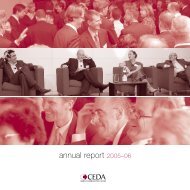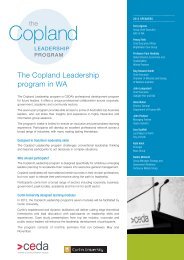A Greater Australia: Population, policies and governance - CEDA
A Greater Australia: Population, policies and governance - CEDA
A Greater Australia: Population, policies and governance - CEDA
- No tags were found...
Create successful ePaper yourself
Turn your PDF publications into a flip-book with our unique Google optimized e-Paper software.
Section 2.1Its (Treasury’s) projections of future budgetary costs in 2049–50 are of no value.Treasury does not know with any precision what will happen in the next 40 years.IGR1, in 2002, told us that by 2041–42, the ageing of society would put the budgetin deficit by five per cent of GDP. Yet by 2007, IGR2 had virtually halved the forecastdeficit that year to 2.7 per cent of GDP. And now IGR3 has halved it again to aforecast deficit of just 1.3 per cent of GDP. 5Successive reports have shown absurdly different population projections. Forexample, IGR2002 estimated that, 40 years later, <strong>Australia</strong>’s population would be25.2 million. Five years later, IGR2007 predicted that the population would rise to28.5 million. Three years later, IGR2010 predicts <strong>Australia</strong>’s population in 2050 willbe 35 million. The differing reports show that Treasury’s population predictions areworthless. 6The disdain from these journalists arose from the high degree of inconsistency betweenthe three successive IGRs, over a period of just seven to eight years as shown inTable 1.Table 1<strong>Population</strong> <strong>and</strong> Fiscal Deficit Outcomes in Successive IntergenerationalReports(Millions)End Point Fiscal Deficit(as a % of GDP)IGR1: 2002/03 25.2 5.0IGR2: 2007 28.5 2.7IGR3: 2010 35.9 1.3Really Big <strong>Australia</strong> 0?In fact, the differences between the IGRs are due very largely to the effects of higherlevels of migration upon the age structure of the population. The age distribution of netmigration to <strong>Australia</strong> in recent years has been very young, younger than it has everbeen, with over 70 per cent of net migration being aged less than 30 years. 7 Many ofthese immigrants go on to have babies in <strong>Australia</strong> adding to the impact of immigrationon the age structure. The popularly heard view that immigration does not influence theage structure because immigrants themselves grow old is incorrect. Immigration hasonly a small impact on the age structure because the annual number of immigrants issmall compared to the size of the total population. The impact of immigration on agestructure is also subject to diminishing returns, that is, the effect becomes smalleras migration increases. This is why, as shown in Table 1, it takes lots of immigrants<strong>and</strong> lots of population increase to have a relatively small effect on the age structure ofthe population. Nevertheless, an increase of population from 26 million to 36 millionreduces the fiscal deficit from five per cent to 1.3 per cent of GDP.The release of the 2010 IGR gave release to a debate about the desirable size of<strong>Australia</strong>’s population in the future. This debate continued through the 2010 Federalelection with both major parties promising to lower migration. Labor proposed futurenet migration of 180,000 per annum <strong>and</strong> the Coalition, 170,000 per annum – essentiallythe same levels used in the 2009 ABS projections <strong>and</strong> the 2010 IGR projectionsthat led to the projected population of 36 million by 2050. The political debate also ledto the appointment of a Minister for <strong>Population</strong>, the first in <strong>Australia</strong>’s history. Underhis overview, an enquiry into <strong>Australia</strong>’s future population was launched. The enquiryreported in June 2011. The most significant statement in this report is the following:A <strong>Greater</strong> <strong>Australia</strong>: <strong>Population</strong>, Policies <strong>and</strong> Governance52





